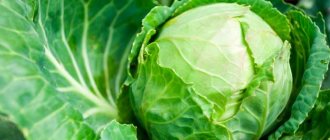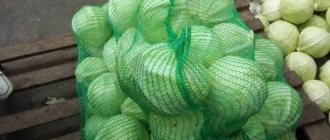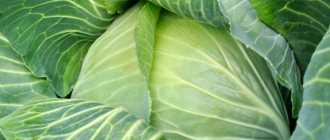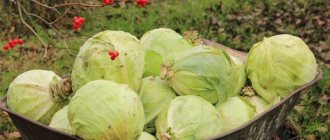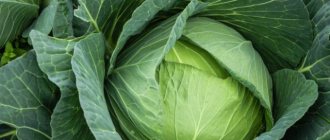Kalibos cabbage has an original shape in the form of an elongated cone and a colorful outfit (the color of the cabbage is lilac-red). The variety is valued among farmers for its high productivity, adaptability to changes in weather, and excellent taste.
| Landing location | Ripening time | View | Purpose | Origin | Maturation period | Weight |
| Greenhouse, Open ground | Mid-season | Red cabbage | Fresh | Variety | 140-150 | 1-1,5 |
What type of cabbage is this?
Red cabbage Kalibos belongs to the Czech line of selection and is recommended for cultivation in garden plots, household plots and small farms. Forks are characterized by an unusual cone shape, sweet taste, and are suitable for pickling and fresh consumption.
Brief history of origin and distribution
Calibos is a variety of red cabbage bred by Czech breeders of the Moravoseed company. Included in the State Register of Breeding Achievements of Russia in 1997 with permission for cultivation in all regions.
Landing location
Seedlings are transplanted into open ground at the age of 40-50 days (usually by this time 4 true leaves are formed), at the end of April (early varieties) - beginning of May, when the risk of severe frosts will be minimal.
Before planting, the soil must be well prepared, dug up with a shovel full, simultaneously removing all weeds and adding 2 kg of humus and a couple of teaspoons of nitroammophoska per square meter for digging.
Before preparing the soil, you need to decide on the location for planting the seedlings; it should be level, rain or irrigation water should not stagnate on it, and cruciferous crops should not grow before that for about three seasons. The optimal predecessors for red cabbage are all legumes without exception, cucumbers, onions, potatoes, beets, tomatoes, and all perennial herbs.
Characteristics and description
This is a mid-season variety of red cabbage. The crop reaches technical maturity 140-150 days after the emergence of full shoots. Marketable yield is 580-640 c/ha.
Appearance and taste
Kalibos cabbage is a tall plant with a semi-vertical leaf rosette 30-40 cm high and 50-70 cm in diameter. The covering leaves are medium-sized, concave, slightly bubbly, medium wavy, dark red in color and broadly elliptical in shape, covered with a medium waxy coating. The height of the outer stalk is 25-35 cm, the inner one is 15-20 cm.
The variety produces partially covered, medium-dense cone-shaped heads that reach 25-35 cm in length, 50-70 cm in diameter at the widest part and weigh 1.5-2 kg. In cross-section, the fork is red-violet in color.
Calibos is characterized by juiciness, sweet taste and delicate texture.
Temperature resistance
Seeds germinate even at temperatures of +2...+3°C, but at +11°C seedlings appear after 10-12 days, and at +20°C – after 3-4 days.
Seedlings can withstand short frosts down to -6°C, heads of cabbage - up to -8°C. Prolonged exposure to temperatures above +25°C negatively affects the formation of heads.
Moisture and drought resistance
Hot weather and prolonged drought lead to increased accumulation of nitrates in cabbage. Calibos tolerates excessive moisture better - excess moisture does not provoke rotting or cracking of vegetables.
Resistance to diseases and pests
The variety is resistant to most diseases and pests characteristic of the crop, but it can be attacked by whiteflies, cutworms and aphids.
This is interesting:
Description, cultivation, popular varieties of Savoy cabbage
Sauerkraut - composition, benefits and rules of use
Mid-season hardy cabbage hybrid SB 3 F1
Features of agricultural technology
Cabbage is suitable for growing by seeds or seedlings. To obtain high-quality heads, several rules of agricultural technology should be taken into account:
- sow seeds in well-heated soil to a depth of 1.5 - 2 cm;
- start growing seedlings at least 30 days before planting;
- move seedlings that have 5 leaves to the beds;
- for cabbage, choose areas with medium or low soil acidity;
- Watering should be carried out as the soil dries out, using the principle of sprinkling.
Advice. To prevent diseases, cabbage should not be grown in one place for several years in a row. You can use the bed again after 4 years.
Sowing seeds for seedlings | Planting seedlings in a greenhouse/greenhouse | Planting seedlings in exhaust gas | Harvesting |
| April | May | The end of May | Aug. Sept |
| *dates are indicated for central Russia | |||
Advantages and disadvantages of the variety
The main advantages of Kalibos cabbage:
- abundant yield;
- moisture and frost resistance;
- high taste qualities;
- possibility of universal use;
- amicable maturation;
- immunity to characteristic diseases;
- original appearance of the heads;
- high commercial qualities;
- unpretentiousness.
Disadvantages of the variety:
- demands on soil composition, watering and fertilizing;
- short shelf life;
- possibility of manual harvesting only;
- poor transport tolerance.
Growing technology
Kalibos cabbage is grown by seedlings and without seedlings; the main thing is to take into account the climatic conditions of the region, choose the right site, observe planting dates and care requirements.
Optimal conditions
For planting, choose a well-lit place, protected from gusty winds and drafts, with soil that has slightly alkaline (pH 7-7.5) or neutral (pH 6.5-7) acidity. The best option is clay or loamy soil.
The area is prepared in advance - cleared of weeds and plant debris, dug up on the bayonet of a shovel and 2 kg of humus and 2 tsp are added. nitroammophoska for every 1 sq. m.
The best predecessors are legumes, cucumbers, onions, potatoes, beets, tomatoes and perennial herbs.
Important! Cabbage can be planted in the same place no earlier than after 4 years.
Landing dates and rules
Seeds for seedlings are sown in early April. More precise dates are determined based on the fact that seedlings are transplanted into open ground at the age of 40-45 days.
To disinfect, planting material is pre-soaked for 25-30 minutes. in a solution of potassium permanganate, and then to improve germination, immerse in hot (no more than +50°C) water.
Sowing technology:
- Place a drainage layer of expanded clay or fine charcoal in prepared containers with a depth of at least 7 cm.
- Pour a substrate suitable for seedlings on top (humus, turf soil and lowland peat with neutral acidity in a ratio of 2:1:1) and water it.
- Place the seeds on the surface of the soil at a distance of 2-3 cm from each other, deepening them by 1-1.5 cm.
- Spray a solution of potassium or sodium humate on them using a spray bottle, sprinkle with dry substrate (layer thickness - 0.5 cm).
- Cover the containers with the crops with polyethylene and put them in a warm (about +20°C) place.
After the emergence of seedlings, the polyethylene is removed, and the temperature is maintained at +15...+18°C during the day and +8...+10°C at night. The duration of daylight for seedlings should be at least 8-10 hours. If necessary, use fluorescent lamps for additional lighting.
Watering with a spray bottle is carried out as needed, without allowing the substrate to dry out completely, using settled water at room temperature.
In the cotyledon phase, the seedlings are planted in individual containers, and a week before planting in open ground they begin to harden them, exposing them to the open air for several hours at a temperature of +4...+5°C and for the whole day at +8°C.
The seedlings are fed twice: in the phase of 2 true leaves and 7-10 days before transplanting into the ground, using a solution of nitroammophoska (15 g per bucket of water) at the rate of 15 ml per plant for the first time and 50 ml for the second.
Transplantation of seedlings into the ground is carried out at the end of May, when the seedlings reach a height of 19-21 cm and form 4-6 true leaves.
Landing rules:
- In the prepared area, form beds at a distance of 60 cm from each other.
- Make planting holes about 15 cm deep every 50 cm.
- Pour 1.5 liters of water into each and add 150 g of wood ash.
- Place the seedlings in the holes together with a lump of earth, sprinkle with soil and water at the rate of 1-1.5 liters of water for each plant.
When growing without seedlings, the seeds are sown in a greenhouse or greenhouse in early May.
Red cabbage. When and how to plant cabbage in open ground.
Further care
Watering is carried out as needed, without allowing the soil to dry out completely: it should be moistened to a depth of 2-2.5 cm. On average, cabbage is watered 8-12 times per season, focusing on the amount of precipitation and climate of the region - the more rain, the less often the plantings are watered.
Reference. Watering is carried out by sprinkling, using settled warm (+20…+25°C) water.
After each watering or rain, the soil is carefully loosened to a depth of 4 cm to improve its moisture permeability, aeration and to prevent the formation of a dry crust on the soil surface. At the same time, the soil is weeded, getting rid of weeds, which take moisture and nutrients from it and create favorable conditions for the development of diseases and pests.
Fertilizers are applied twice:
- 10-12 days after transplanting the seedlings into the ground - 10 liters of nitroammophoska solution (2 tsp per 10 liters of water) per 1 sq. m;
- before closing the rows - 10-12 g of nitrophoska for each plant.
Hilling is carried out 2-3 times with an interval of 5-7 days at the initial stage of formation of heads of cabbage, until the leaf blades close.
Possible problems, diseases, pests
Pests that can attack Calibos are presented in the table.
| Pest | Signs | How to get rid |
| Whitefly | The pest larvae suck out plant juices and leave behind a sweet liquid on which sooty fungi settle. | Plantings are treated with Zeta, Rovikurt, Fufanon, Fitoverm, Aktara, Konfidor, Tanrek. Among the folk remedies, infusions of dandelion, garlic, tobacco and soap solution help get rid of pests. |
| scoop | During the seedling growth stage, the pest's caterpillars gnaw the stems of the seedlings and the plants fall. During the ovary of heads of cabbage, pests eat the pulp of the leaves, leaving only thick veins. | Treatment with the preparations “Dendrobacillin”, “Bitoxibacillin”, “Lepidocid”, “Fitoverm”, “Agravertin”, “Fury” or decoctions of wormwood, tomato tops, hot red pepper. |
| Aphid | The leaves become faded and brittle, yellow spots and a sticky, dirty coating appear on the plant. | Cabbage is treated with insecticidal preparations, for example, Pyrethrum, Karbofos or Iskra. |
How to care for red cabbage in open ground
There is nothing unusual in caring for red cabbage: you need watering, fertilizing, and loosening. Water is especially required in the first week, while the seedlings are taking root, as well as during the filling of heads of cabbage. In the first days, it is advisable to add a glass of water to each plant every day, and in case of sunny weather, shade the bushes with paper caps. Subsequently, the frequency of watering is reduced to once a week, but by the time heads begin to form, each plant requires several liters of water. Watering is reduced 2 weeks before harvest to prevent the heads of cabbage from cracking.
After each watering, loosening the soil is required until the leaves of neighboring plants close together: after this, its own microclimate will be established in the bed under the leaves. As cabbage grows, it requires hilling, which significantly increases the yield. Early varieties are hilled twice, late varieties - 3 times per season. In this case, moist soil must be pushed towards the roots, so hilling is timed to coincide with watering.
The time is coming, and the cabbage has no time to loosen, we must prepare to give away the harvest
It is convenient to coincide with watering and fertilizing, which is carried out at least twice during the growing season of red cabbage.
At the beginning of growth, cabbage most of all needs nitrogen, and during crop formation, on the contrary, phosphorus and potassium.
It is best, of course, to use infusions of organic fertilizers for fertilizing, but during the second fertilizing, you must add ash and maybe a little superphosphate to the mullein infusion. Nutrient solutions are poured into the grooves made in the middle of the rows, after which they are covered. For late varieties intended for winter storage, the amount of potassium should be increased, so a third feeding is needed, carried out 3-4 weeks before harvesting the heads of cabbage. At this time, at least 15 g of potassium chloride or sulfate must be added per 1 m2 of bed, which can be replaced with a large amount of wood ash (let two handfuls stand in a bucket of water for a day, dilute several times and distribute this amount of nutrient mixture over a dozen plants).
To repel pests, cabbage is sprayed with folk remedies: infusions of tomato or potato tops, hot pepper. Tobacco or ash infusion is effective against aphids.
To make repellent solutions stick better to the leaves, add a little laundry soap when preparing them.
Red cabbage, unlike, for example, Savoy cabbage, cannot remain in the garden under the snow; it must be removed before the onset of severe frosts. Most varieties are transportable and store well in the cellar for several months, and the most valuable varieties until summer.
Video: red cabbage salad
Features of cultivation depending on the region
Kalibos cabbage is successfully cultivated in all regions of Russia. The variety tolerates low air temperatures and high humidity levels well, so its basic care requirements do not change depending on the climate of the region.
Some nuances include the need for more frequent watering in the southern regions, which are characterized by an arid climate, and the timing and method of planting the crop. Thus, in the middle zone, the seedling method is more often used, in the south - seedless technology.
Main diseases and pests
This variety of cabbage is affected by diseases and pests much less frequently than white cabbage. The main dangers for red cabbage are pests such as:
- slugs;
- cabbage moth;
- caterpillars of cabbage white and cabbage cutworm;
- cruciferous flea beetles.
To combat pests, well-proven biological products are used: Agravertin, Fitoverm, etc.
Folk remedies are also used to repel insects. Cabbage is treated with infusions of red pepper, potato tops and tomatoes.
There is an article on our website that we recommend you read: “How to get rid of cruciferous flea beetle on cabbage and prevent its proliferation.”
The following composition is used against slugs: mix 0.5 liters of wood ash, 1 tbsp. l. dry mustard, salt and ground pepper. In sunny weather, this mixture is used to pollinate the soil between the plants and immediately loosen it to a depth of 3-5 cm. In the evening, the same mixture, only without salt, is used to pollinate the plants through a gauze bag.
The most common disease of cabbage is clubroot; less commonly, plants are affected by vascular or mucous bacteriosis, black leg, and powdery mildew.
Don't wait for diseases to attack cabbage. For the purpose of prevention, plants are watered once every 2-3 weeks with a solution of Fitosporin. The same is done with all other crops on the site. The drug is safe, vegetables and fruits can be consumed on the day of treatment, after washing with water.
The biological product Zircon fights well against all fungal and bacterial diseases. Measures such as crop rotation, seed disinfection and timely removal of weeds will help reduce the risk of disease development.
Read also about the fight against pests and diseases of cabbage here.
Reviews from summer residents
Farmers respond positively to the variety.
Elena, Moscow region: “ This is very tasty cabbage - sweet, juicy, tender, crispy. Ideal for salads, but even pickled, it’s simply delicious. Previously, I only planted white cabbage all the time, now I can’t imagine how you can do without Calibos.”
Lyudmila, Moscow region: “I saw this cabbage from a neighbor and at first became interested in the variety only because of the unusual shape and bright color of the heads. But Calibos surprised not only with its appearance, but also with its amazing sweet taste. Even children eat this cabbage with pleasure.”
Olga, Bryansk region: “The variety is excellent - the heads of cabbage are beautiful, of an unusual shape, very tasty, suitable for salads and for pickling. Care is very simple, the yield is high. It’s just a pity that the heads of cabbage don’t last long – only a few months.”
This is interesting:
Simple but very tasty recipes for red cabbage, pickled in pieces
Simple and tasty ways to pickle red cabbage in jars for the winter
Unusual Vegetables: Conical Cabbage
Adding an article to a new collection
Do you want to try growing something new on your plot, but don’t trust exotic things too much? Note the conical cabbage.
White cabbage occupies a special place in Russian cuisine. Whatever they do with her! They are salted, pickled, stewed, added to soups and a variety of baked goods. It is not surprising that white cabbage was nicknamed the third bread for such “multi-plantability.” Lovers of salads made from fresh herbs are especially sensitive to this vegetable. After all, early ripening varieties of cabbage, including conical cabbage, can please you with a harvest as early as June. The word conical cabbage was specially bred for those who can't wait to treat themselves to a fresh salad. Some hybrids of conical cabbage, for example, Karamba F1, are capable of producing a harvest no later than 70 days after planting, even in unfavorable weather conditions, but if the heavenly office pleases with warmth, then these periods can be reduced to 55-60 days.


